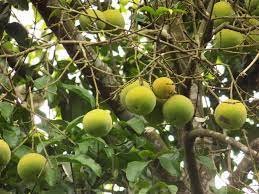NAME: Garcinia kola
FAMILY: Clusiaceae
COMMON NAMES: Bitter kola, Garcinia kola, False kola
LOCAL NAMES: I "Orogbo" "Agbilu" "Namijin Gworo"
MORPHOLOGICAL DESCRIPTION: Garcinia kola is a small tree that typically reaches a height of 10 to 15 meters (33 to 49 feet). It has a straight, cylindrical trunk with smooth, grayish bark. The leaves are dark green and glossy, arranged opposite each other on the branches. The tree produces small, greenish-yellow flowers that develop into round, woody fruits with a hard shell. The seeds within the fruits are often referred to as bitter kola nuts.
USEFUL PART(s): The seeds (kola nuts) of Garcinia kola are the most commonly used part of the plant.
GENERAL USES:
Medicinal Purposes: Garcinia kola has a long history of traditional medicinal use in West Africa. The seeds are highly valued for their medicinal properties and are used to treat various ailments. They are believed to possess anti-inflammatory, antimicrobial, and antioxidant properties. Bitter kola is often chewed or used to prepare herbal remedies for conditions such as cough, bronchitis, fever, digestive disorders, and arthritis.
Cultural Significance: Bitter kola nuts hold cultural significance in some West African communities and are commonly used as a social and ceremonial stimulant. They are frequently offered as gifts during celebrations and religious ceremonies.
GEOGRAPHIC DISTRIBUTION: Garcinia kola is native to tropical rainforests in West and Central Africa. It is found in countries such as Nigeria, Ghana, Cameroon, and Ivory Coast.
WHY IS IT GREEN? The leaves of Garcinia kola are green due to the presence of chlorophyll, a pigment responsible for capturing light energy and facilitating photosynthesis. Chlorophyll allows the plant to convert sunlight, carbon dioxide, and water into glucose and oxygen, providing energy for its growth.
ENVIRONMENTAL IMPACT: Garcinia kola plays a significant ecological role in its native habitat. As a tree species, it contributes to forest structure and biodiversity, providing habitat and food sources for various organisms. However, deforestation and unsustainable harvesting of Garcinia kola trees for their valuable seeds can have negative environmental impacts, such as habitat loss and reduced biodiversity.
FUN FACT: In some West African cultures, bitter kola nuts are believed to have aphrodisiac properties and are used as a natural remedy to enhance sexual performance.
Further Reading: If you're interested in learning more about Garcinia kola, its traditional uses, and scientific studies conducted on its medicinal properties, here are a few suggested resources for further reading:
Amusan, O. O., et al. "Garcinia kola (Heckel) seeds improve semen and testicular parameters of Wistar rats." Journal of Complementary and Integrative Medicine 14, no. 3 (2017): /j/jcim.2017.14.issue-3/jcim-2017-0017/jcim-2017-0017.xml.
Olorunfemi, O. J., et al. "Antimicrobial activities of bitter kola (Garcinia kola) against pathogens." International Journal of Pharmacy and Pharmaceutical Sciences 6, no. 7 (2014): 428-432.
Adaramoye, O. A., et al.


